2008 Hummer H3 Alpha vs. 2008 Jeep Wrangler Unlimited
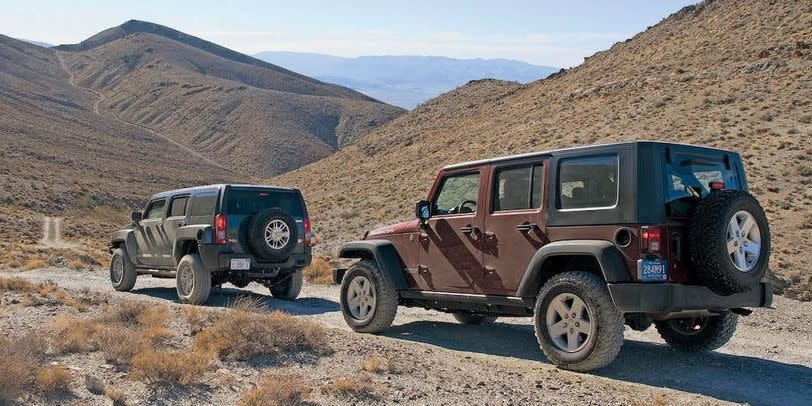
From the April 2008 issue of Car and Driver.
Glaciers that were ducking and running from Southern California about two million years ago left behind a deep thumbprint in the jagged desert backcountry 200 miles straight north of Los Angeles. The Saline Valley was so named by 19th-century prospectors who stumbled upon the exceptionally pure salt playa left at the valley’s low point, like a bathtub stain.
You don’t need a Hummer or a Jeep, but everybody needs salt, about one-quarter teaspoon daily, the federal government reckons. And back in 1911, when salt harvesting in the Saline Valley achieved industrial scale, salt was the primary food preservative. However, mules couldn’t get the twinkling cake back to civilization profitably. So from 1911 to 1914, with typical how-the-West-was-won gusto, the Saline Valley Salt Company tackled the problem by constructing a 14-mile aerial tramway, then the longest and highest in the world, to chairlift salt out of the valley.
Pinched between 10,975-foot Mount Inyo to the west and 5678-foot Ubehebe Peak in Death Valley National Park to the east, the Saline Valley is today much as it was then, accessed by just a few rough-hewn trails tracing those left behind by the Panamint Indians. Passage through the Inyo Mountains is by pedigreed off-roader only—unless you’re at the pointy end of an Air Force F-15 Eagle or Marine F/A-18 Hornet. The Saline Valley lies at the north end of the military’s R-2508 Special Use Airspace Complex, a vast air-power playground spanning much of the upper Mojave Desert and reaching from the edge of space to 200 feet above dirt.
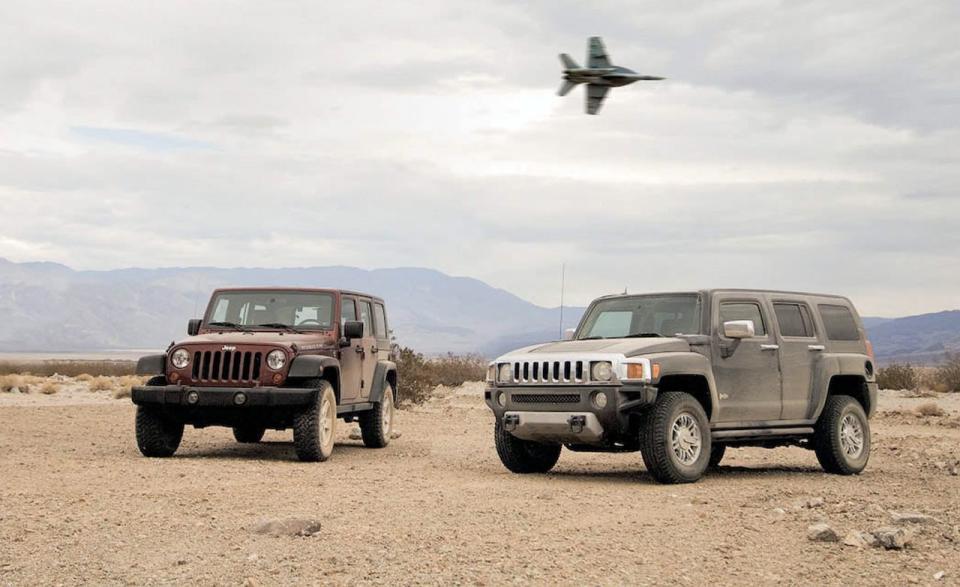
To enjoy the Arsenal of Democracy’s best free, all-day air show, plus examine the tramway towers that are on the National Register of Historic Places after 90 years of defying the torrid desert weather, we saddled up America’s two toughest four-door rawhides.
The Hummer H3 Alpha and the Jeep Wrangler Unlimited Rubicon have the military as their design muse and are outliers in a sport-utility market gone limp-wristed with crossovers. But from there the similarities thin out. Hummer’s newest model, the ’08 Alpha, is leather lined, electronics stuffed, and fitted with a 5.3-liter V-8 inplace of the just-enough base five-cylinder. The sticker starts $9710 higher than the Jeep’s, and with a $1720 navigation system plus an $850 camera for backing up and a $390 trailer hitch, reaches a mighty $42,865, minus the inevitable discounting (at press time, rebates on regular-grade ’07 H3s were $5500).
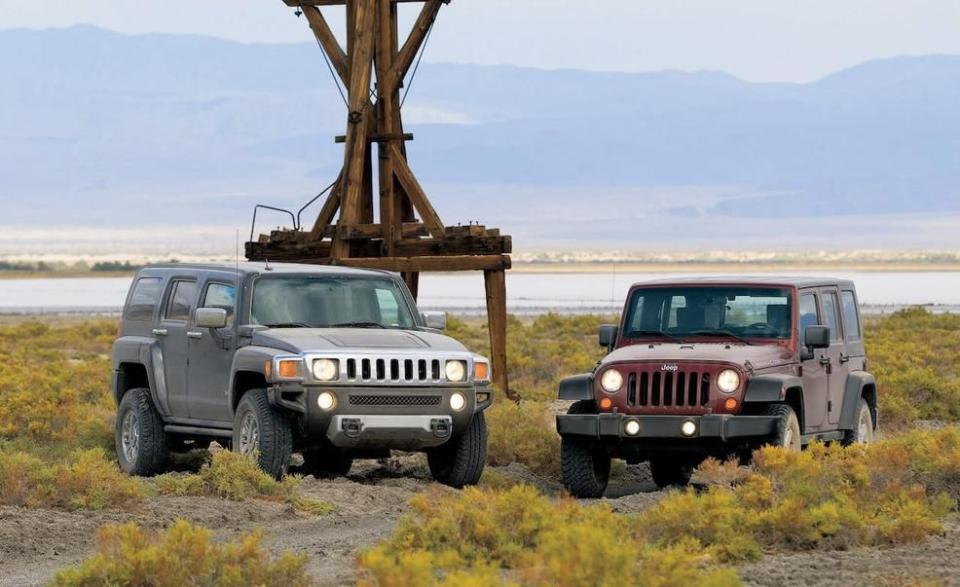
A four-door Wrangler was added to the lineup for the 2007 model year to ovations from Jeep fans. Starting at $30,195, Unlimited Rubicons get front and rear lockable differentials, crawl gearing, a switch to disconnect the front anti-roll bar for more axle swing, and 32-inch BFGoodrich rock eaters. Except for the $1275 nav and multimedia system, our options were three figures or less: $825 for the automatic trans, $695 for the Freedom Top removable three-piece hard roof, $225 for pearl-coat paint, and $50 for floor mats. Total: $33,265.
The base five-cylinder H3, starting at $31,340, makes a closer competitor to the Rubicon, but the Alpha is new and untested, and the Unlimited had yet to make a comparo roster. Until now.
Second Place: Hummer H3 Alpha
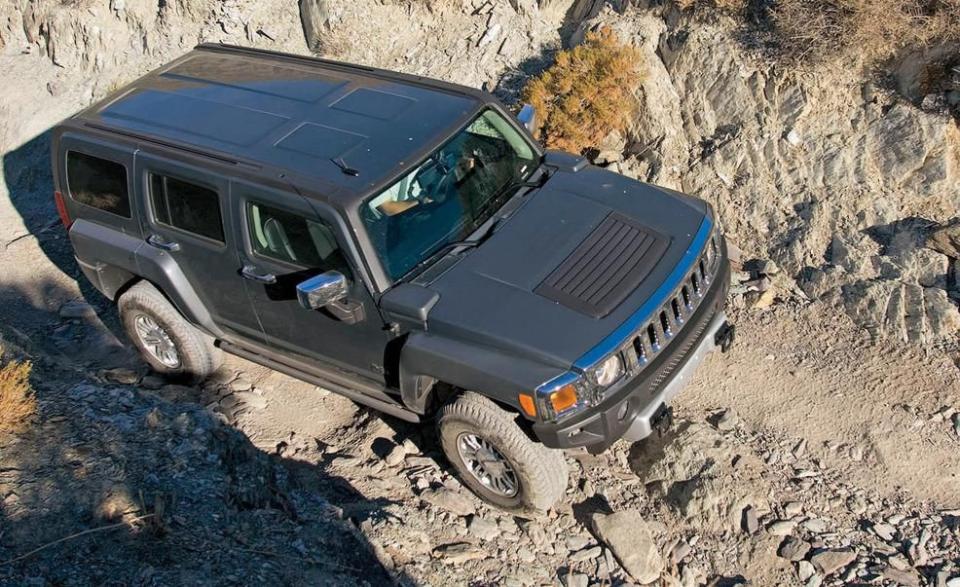
Erected by mule teams from stout red-pine timbers, the salt tramway’s towers carried cables that were strung from one precarious outcropping to the next, in some places nearly vertically, up 7400 feet to a saddle in the Inyo Mountains. From a transit station once manned in the warmer seasons by a very lonely family, the 300 buckets in circulation then plunged 4900 feet to waiting rail cars. At its peak before depleting the playa and shutting down in 1936, the tramway deposited 20 tons of salt per hour on the tiny hamlet of Swansea in the adjacent Owens Valley.
HIGHS: V-8 haste without a big fuel bite, Cadillac trimmings, capable in the bush.
LOWS: Pinched visibility, narrow rear doors, double-take sticker price.
Steering 2.5 tons of locked-and-loaded Hummer back the other way is breezy work, thanks to the Alpha’s robust V-8. It has muscle enough to tow 6000 pounds (to the Jeep’s 3500) and stampede past 60 mph in 8.9 seconds with a manly small-block snort. On the blacktop, the Alpha skiddoos into traffic more eagerly and holds a highway speed more effortlessly and with less engine-room moan than the Jeep. As we expected a mileage meltdown, our gorp-stuffed gobs were thoroughly smacked when we learned that, returning 14 mpg, it gives up just 1 mpg to the Jeep’s V-6 and to our last five-cylinder H3 test vehicle.
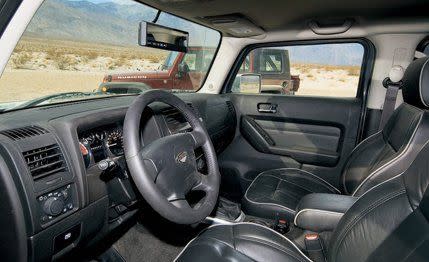
In the highlands, the H3 demands a careful helm lest it be clawed by every juniper bush and cayenne-colored manzanita along the trail. The Hummer is nearly an inch wider than the already brawny Jeep, so its wheel placement is further complicated by pinched visibility through the narrow side glass. It’s a cave inside, and day practically turns to night when the backup-camera screen slides sideways out of the blocky rearview mirror, doubling an already large obstruction hindering forward sightlines.
As a gull-gray F-15 whooshed overhead, tipped on a knife’s edge and almost low enough to read the cockpit dials, we probed a particularly gentle and fine-grained throttle that tiptoes the Hummer with grace over crags. Unlike the Jeep, the H3 is always in four-wheel drive and never short on grip. A three-button control shifts it among four high, four low, and four high with the center differential locked.
Even lacking the optional 4.03:1 low-range transfer gear (2.64 is standard), the H3 scrambled with secure footing up steep inclines slippery with loose debris, including the salt that for years leaked out of the buckets as they passed overhead, for a time painting the Inyo Mountains with their own racing stripe.
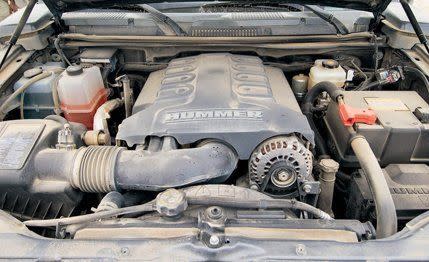

 Yahoo Autos
Yahoo Autos 